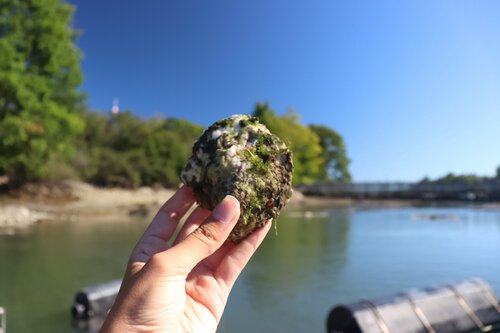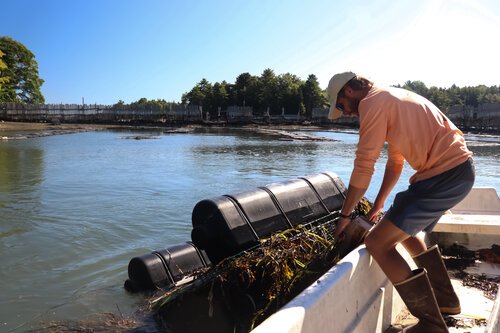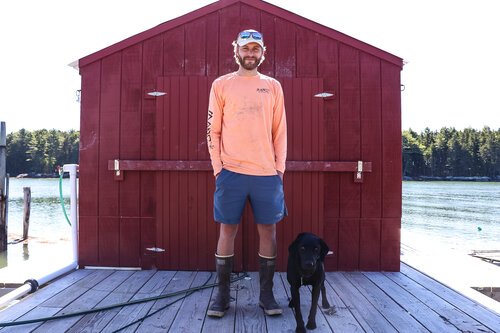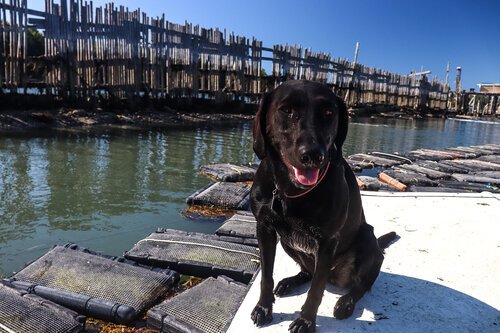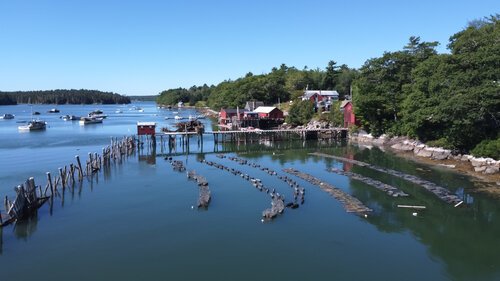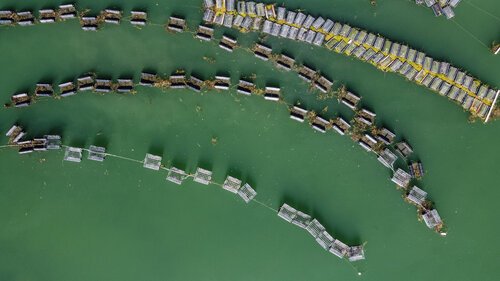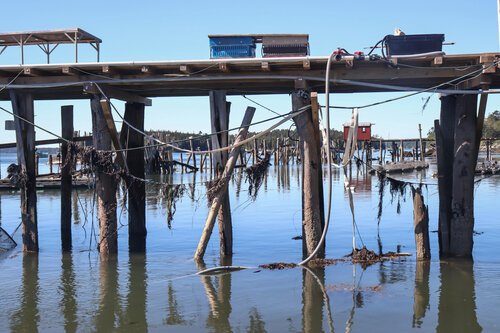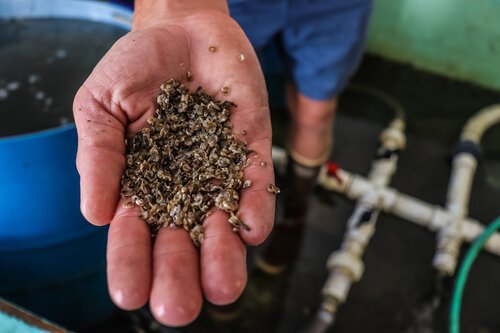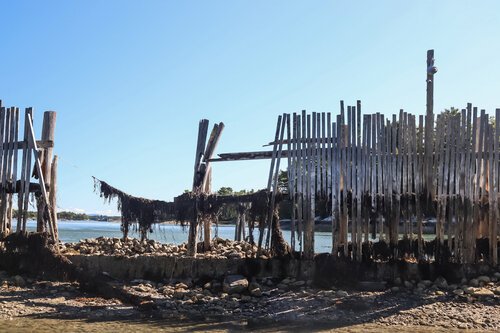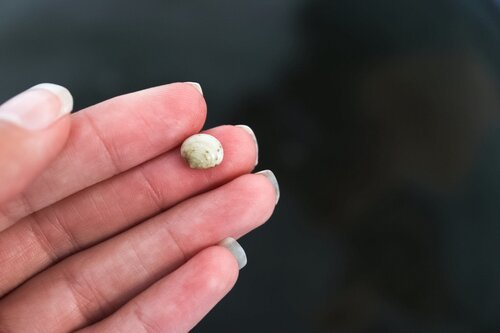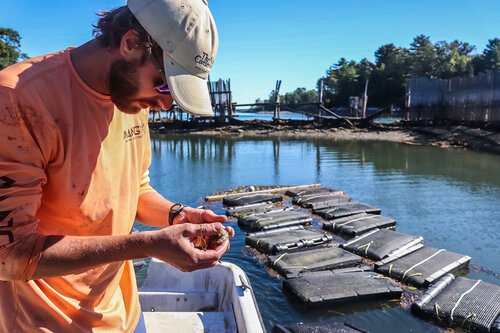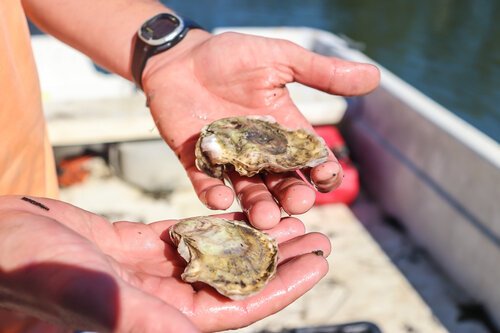What’s In a Name? The Story of Community Shellfish Company and the Cora Cressy Oyster
Named after a five-masted schooner that served as a speakeasy during the Prohibition era, the Cora Cressy Oyster, farmed by oyster farmers Boe Marsh and Zak Alexander of Commuinty Shellfish, is grown in the waters of a grandfathered lobster pound in Bremen Maine on the Medomak River.
I like my oysters to have names that tell me a story. Typically, an oyster’s name pays homage to the cold-churning waters in which the bivalve grows, such as an emerald Nonesuch or a pristine Johns River. Other times, the bivalve conjures up images of a nearby geographical landmark, looming in the distance of the oyster’s nesting grounds, such as a North Haven or a Bar Harbor Blonde.
I came across an oyster by the name of “Cora Cressy” a few years ago while dining in the Damariscotta region of Maine. Farmed by local oystermen Boe Marsh and Zak Alexander of Community Shellfish, the Cora Cressy name intrigued me. The word “cora” is the epithet for the Greek goddess Persephone, roughly translated to “heart,” and “cressy” is a surname harkening back to the Middle Ages for folks hailing from the Normandy region of France.
Covered in a delicate tangle of vibrant green algae, I sensed the story behind the Cora Cressy oyster was an intriguing one.
I met Community Shellfish Company farm manager Zak Alexander, and his raven-black four-legged companion Sepala, at a lobster pound in Bremen, Maine on a warm golden morning. Community Shellfish is a multifaceted business consisting of an oyster farm, which grows the mythological Cora Cressy oyster, as well as a Maine seafood distributor which purchases and sells products from the local fishing community. Both the Community Shellfish oyster farm and the processing and distribution center are located in Bremen, a small town hugging the edges of the mouth of the Medomak River, where it empties into the Muscongus Bay.
As I stepped out of my car, I was immediately awestruck by the scenery. There could be nothing more quintessential “New England oyster farm” than oysters growing in the waters of a lobster pound, with a fully-operational working waterfront teeming in the distance. It was, hands-down, one of the most picturesque oyster farms I have ever visited, and I sensed I was about to become enmeshed in some exciting lore of the surrounding waters.
Zak, originally from upstate New York, smiled to himself as he surveyed the scenery during our stroll to the Community Shellfish lease site along the Medomak River. As we sauntered with Sepala playing with stray lobster buoys along the way, Zak explained he spent his summer vacations visiting his family in the Damariscotta region of Maine, and fondly recounted regular outings to Glidden Point Oyster Farms.
“I always felt more at home in this part of Maine than anywhere else in New York,” Zak confided as we approached the lobster pound. “Even when I was little, I always wanted to make this place my home and work on the water.”
Staring at the long lines of oyster cages strewn across the emerald green waters of the Medomak, the allure Zak described was abundantly clear.
The Medomak Riverway is popular amongst fishing and lobstering fleets. During my time on the Medomak with Zak, we would periodically quiet our conversation and watch as a rugged lobster boat eased its way up the channel and into the neighboring dock. The surrounding waterfront was bustling, and the characters were vibrant—the perfect personification of a MidCoast Maine fishing community.
Community Shellfish owner Boe Marsh purchased the business back in 2018. Originally a co-op consisting of local clam diggers and lobstermen, Boe sought to maintain the business’ community-centric focus, while growing the organization to become a premier dealer and processor of quality Maine seafood. Community Shellfish purchases seafood such as lobster, steamer clams, oysters, and seasonal specialties like dayboat scallops, razor clams, and whelks directly from local fishermen and aquaculturists. The company then processes the seafood in its state-of-the-art facilities, and ships them nationwide to restaurants, wholesalers, and home cooks alike.
As Zak toured me around the Community Shellfish-owned docks and piers on the Medomak, he explained “the goal of Community Shellfish is to support local Maine community, from the fishermen and shellfish farmers from whom we buy seafood, to consumers, who have the opportunity to purchase pristine-quality products from the working waterfront.”
Boe and the Community Shellfish team own 9 acres of property on the Medomak River, which includes a lobster pound, a fully operational lobster dock and service station, and 19 moorings. This allows the Community Shellfish team to interact regularly with the fishermen and lobstermen from whom it purchases products. In its first year under Marsh’s new ownership, Community Shellfish sold over 400,000 pounds of lobster alone to eager consumers—a tremendous testament to the local lobstering community in the Damariscotta area.
In addition to being a premier processor and distributor of Maine seafood, Community Shellfish also launched an intensive aquaculture program in 2017 in the waters of the Medomak, incorporating oysters and quahog clams.
Community Shellfish has two lease sites within a “grandfathered” lobster pound enclosure, constructed in the 1930s, that sits at the mouth of the Medomak River. Pounds are partitioned areas where lobsters were once stored for purposes of market timing. While this practice is no longer employed on the Medomak, the infrastructure of the pound remains very much intact, and offers an excellent opportunity to create a controlled environment in the open ocean.
“During low tide, the pounds hold a few feet of water which is warmed by the sun, which, in turn, promotes algae growth. This increased algae production provides extra food for the oysters twice a day,” Zak explained, as he led me along the wharf running perpendicular to the lobster pound’s sluices. “Plus, we get the high salinity from the nearby Atlantic and added chlorophyll from the algae growth – it’s great for the oysters.”
Once in one of the farm’s skiffs, Zak pointed out where the man-made sluices poured briny water from the Atlantic Ocean during high tide into the lobster pound. Zak constructed the lease site in such a way that the market-ready oysters would be situated nearest to the sluices, and bathed in the incoming briny waters before being harvested for local restaurants.
Currently, Community Shellfish operates two leases within the lobster pound, and has plans of expanding. The farm diversifies its seed class to ensure optimal success by purchasing 2mm seed from both Muscongus Bay and Mook Sea Farms –Maine’s two largest oyster hatcheries. This summer, the farm also purchased some quahog seed to add to the mix. Zak, too, has experimented with various methods to grow-out the Cora Cressy oysters in the lobster pound, taking advantage the distinctly unique make-up of the lease site’s sedimentary layers.
“The vast array of bottom make-up actually helps me organize the farm into different grow-out methods,” Zak explained, as he gestured to the various long-lines strewn across the aquamarine waters. “I run our floating cages over the first two-thirds of the lease site, because the bottom sediment is comprised of roughly 18 inches of shellfish hash and deep mud. Then, I bottom-plant some of our oysters near the sluiceways, allowing them to form some lovely fluted edges. I hand-harvest those via scuba diving.”
Zak stopped the skiff momentarily to pull a mesh bag out of the water, and pluck from it a handful of Cora Cressy oysters. The oysters were covered in a thin layer of brilliant green algae, which tangled its way into the delicate folds of the shells. Zak skillfully shucked several oysters, and handed them to me to try. Deliciously briny with a hint of umami smokiness from the surrounding algae, the Cora Cressy did not disappoint.
“So, how did these creatures get their name?” I asked, the taste of the ocean still lingering on my tongue.
Zak raised an eyebrow, and replied “let me show you.”
Smack dab in the middle of the Medomak River, mere feet away from the Community Shellfish lease site, half-sunk into the water, was a massive conglomeration of dilapidated wooden timbers – perhaps an old dock, or a pier that had fallen into disrepair.
I marveled at the oddity as a stepped up onto the bow of the skiff to get a closer look.
“Ah, the beloved Cora Cressy,” Zak lamented, “there she lies.”
The Cora Cressy was built in 1902 at the Percy & Small shipyard in Bath, Maine. She was a five-masted schooner, 273 feet long and 2499 tons, and was used for transporting coal along the coastline of Maine. In 1928, the vessel took on damage during a tumultuous storm. Although her career as a working vessel ended, her owners had another idea.
In 1929, the Cora Cressy’s owners sold her to become a Prohibition nightclub off the coast of New England, a role she held into the 1930s. Nightly, she was towed three miles offshore into international waters where liquor could legally be served. The Cora Cressy was adorned with crushed velvet curtains, and an opulent interior to fit her new indulgent, and somewhat salacious, occupation. Zak shared that well into the 1980s, you could peek through the Cora Cressy’s broken timbers to see the tattered maroon curtains from her nightclub days.
The end of Prohibition, however, left the Cora Cressy without a career. The owner of a lobster pound in Medomak, Maine, bought her as a storage tank for lobsters, but found the old Percy & Small workers had built her too well—it was impossible to drill enough holes in her hull to enable water to circulate. Thus, she met what some may consider a forlorn fate – as a hulk of a breakwater, half-buried in the mud, barnacles, and mussels that grew up around her.
And there her remains sit today, a testimony to the fall of New England’s sailing fleet from economic powerhouse, to Prohibition speakeasy, to artifact.
After my time on the water with Zak and Sepala, I spent time sitting on the Community Shellfish docks, watching the lobster boats bob gently on the Medomak. The sun climbed its way higher into the horizon, and the waters of the lobster pound twinkled subtly. All the while, the remains of the Cora Cressy stood silently, protecting the secrets of her past, and whispering them only to the oysters who grew in her waters below.


